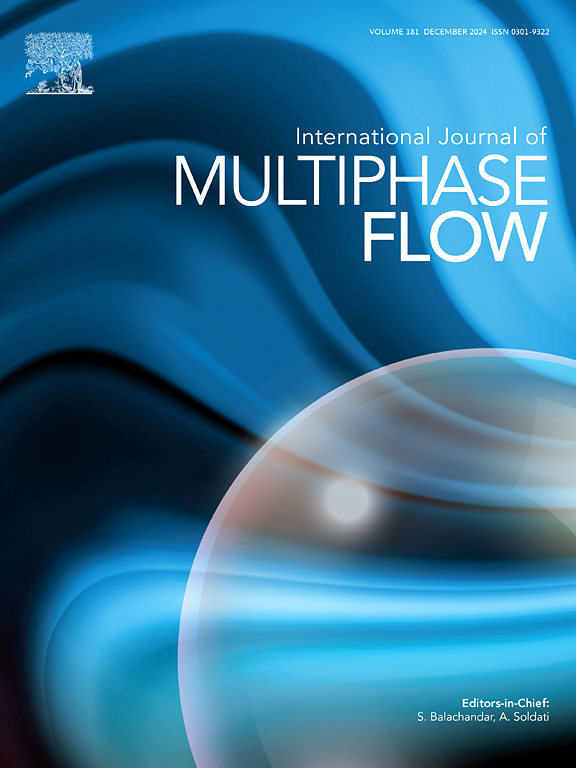基于动态压力信号的垂直管道实时自动流态分类与制图
IF 3.6
2区 工程技术
Q1 MECHANICS
International Journal of Multiphase Flow
Pub Date : 2025-04-08
DOI:10.1016/j.ijmultiphaseflow.2025.105252
引用次数: 0
摘要
准确的流型识别对两相流系统建模至关重要,但关于垂直管道实时应用的文献很少。这项工作旨在利用动态压力信号为垂直管道开发一种实时、自动化、数据驱动的流态分类器。这些信号是通过一个数值模型收集的,该模型代表了3英寸垂直管道中三种不同的流动状态——段塞流、搅流和环空。然后使用离散小波变换(DWT)从这些信号中提取特征。为了优化分类性能,我们评估了12种降维技术,然后应用AutoML框架在k -近邻(KNN)、人工神经网络、支持向量机(SVM)、梯度增强、随机森林和逻辑回归中识别最有效的机器学习分类器,并结合超参数调整。Kernel Fisher Discriminant Analysis (KFDA)的聚类性能最好,而KNN以90.2%的准确率和优异的可重复性成为最佳分类器。利用DWT、KFDA和KNN,构建了一个虚拟流态图,可以通过移动的压力信号窗口实时识别流态。在不同位置使用50.8 mm(2英寸)直径的管道验证了该模型的稳健性和可扩展性。在最后阶段,为水平和垂直管道开发了统一的流态图,使用DWT、KFDA和ANN实现了100%的训练和92.5%的测试准确率。所提出的工作流程代表了自动化流态识别的重要一步,使其能够应用于装有压力传感器的不透明管道,以保证过程工业中的流量和监测。本文章由计算机程序翻译,如有差异,请以英文原文为准。

Real-time automatic flow regime classification and mapping for vertical pipes using dynamic pressure signals
Accurate flow regime identification is essential for modeling two-phase flow systems, but the literature on real-time applications in vertical pipes is scarce. This work aims to develop a real-time, automated, data-driven flow regime classifier for vertical pipes using dynamic pressure signals. These signals were collected using a numerical model to represent three distinct flow regimes—slug, churn, and annular—in a 3-inch vertical pipe. Features were then extracted from these signals using Discrete Wavelet Transform (DWT). To optimize classification performance, twelve dimensionality reduction techniques were evaluated, followed by the application of an AutoML framework to identify the most effective machine learning classifier among K-Nearest Neighbors (KNN), Artificial Neural Networks, Support Vector Machines (SVM), Gradient Boosting, Random Forest, and Logistic Regression, with hyperparameter tuning incorporated. Kernel Fisher Discriminant Analysis (KFDA) demonstrated the best clustering performance, while KNN emerged as the top classifier with 90.2% accuracy and excellent repeatability. Leveraging DWT, KFDA, and KNN, a virtual flow regime map was constructed, enabling real-time flow regime identification with a moving window of pressure signals. Verification of the model using a 50.8 mm (2-inch) diameter pipe at different locations confirmed its robustness and scalability. In the final stage, a unified flow regime map was developed for both horizontal and vertical pipes, achieving 100% training and 92.5% testing accuracy using DWT, KFDA, and ANN. The proposed workflow represents a significant step forward in automating flow regime identification, enabling its application to opaque pipes fitted with pressure sensors for flow assurance and monitoring in process industries.
求助全文
通过发布文献求助,成功后即可免费获取论文全文。
去求助
来源期刊
CiteScore
7.30
自引率
10.50%
发文量
244
审稿时长
4 months
期刊介绍:
The International Journal of Multiphase Flow publishes analytical, numerical and experimental articles of lasting interest. The scope of the journal includes all aspects of mass, momentum and energy exchange phenomena among different phases such as occur in disperse flows, gas–liquid and liquid–liquid flows, flows in porous media, boiling, granular flows and others.
The journal publishes full papers, brief communications and conference announcements.

 求助内容:
求助内容: 应助结果提醒方式:
应助结果提醒方式:


